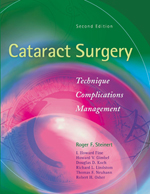Steinert: CATARACT SURGERY: Technique, Complications and
Management 2/e
Table of Contents:
I. EVALUATION
1. The Pathology of Cataracts
2. Surgical Anatomy, Biochemistry, Pathogenesis, and
Classification of Cataracts
3. Preoperative Evaluation of the Patient with Visually
Significant Cataract
4. Intraocular Lens Implant Power Calculation, Selection, and
Ocular Biometry
II. PREPARATION
5. Ophthalmic Viscosurgical Devices: Physical Characteristics,
Clinical Applications, and Complications
6. Biomechanical Characteristics of Suture Materials and Needles
in Cataract Sugery
7. The Phaco Machine: The Physical Principles Guiding Its
Operation
8. Retrobulbar and Peribulbar Anesthesia for Cataract Surgery
9. Topical Intracameral Anesthesia
III. EXTRACAPSULAR CATARACT EXTRACTION
10. Extracapsular Cataract Surgery: Indications and Techniques
11. Phacosection Cataract Surgery
IV. PHACOEMULSIFICATION
12. Incision Construction
13. Capsulorrhexis
14. Hydrodissection and Hydrodelineation
15. Principles of Nuclear Phacoemulsification
16. Phaco Chop
17. Technique of Tilt and Tumble Phacoemulsification
V. SPECIAL TECHNIQUES FOR CATARACT EXTRACTION
18. Pars Plana Lensectomy for Primary Extraction and Retained
Fragments
19. Phacoemulsification in the Presence of a Small Pupil
20. Combined Cataract Implant and Filtering Surgery
21. Combined Cataract Extraction and Corneal Transplantation
22. Control of Astigmatism in the Cataract Patient
23. Cataract Surgery in Uveitis Patients
24. Surgical Management of Pediatric Cataracts
25. The Intumescent Cataract
26. Dense Brunescent Cataract
27. Surgical Management of the Congenitally Subluxed Crystalline
Lens Using the Modified Capsular Tension Ring
28. Techniques and Principles of Surgical Management for the
Traumatic Cataract
29. Iris Repair
30. High Myopia
31. Nanophthalmos, Relative Anterior Microphthalmos, and Axial
Hyperopia
32. Cataract Surgery in the Presence of Other Ocular
Comorbidities
VI. INTRAOCULAR LENSES
33. The Evolution of the Intraocular Lens
34. Polymethylmethacrylate Intraocular Lenses
35. Foldable Intraocular Lenses
36. Multifocal Intraocular Lenses
37. Secondary Intraocular Lenses
38. Intraocular Lens-Related Opacifications
VII. MANAGEMENT OF COMPLICATIONS
39. Intraoperative Complications of Phacoemulsification Surgery
40. Surgical Repositioning and Explantation of Intraocular Lens
41. Wound Dehiscence Following Cataract Surgery
42. Corneal Edema After Cataract Surgery
43. Glaucoma After Cataract Surgery
44. Neodymium:Yttrium-Aluminum-Garnet Laser Posterior
Capsulotomy
45. Neodymium:Yttrium-Aluminum-Garnet Laser in the Management of
Postoperative Complications of Cataract Surgery
46. Epithelial and Fibrous Invasion of the Eye
47. Macular Causes of Poor Postoperative Vision: Cystoid Macular
Edema, Epiretinal Fibrosis, and Age-Related Macular
Degeneration
48. Postoperative Endophthalmitis
49. Retinal Detachment
50. Prolonged Intraocular Inflammation
51. Lasers in Cataract Surgery
52. New Phacoemulsification Technologies
53. Endocapsular Vortex Emulsification for Cataract Removal
BOOKS OF RELATED INTEREST:
Levine: Manual of Oculoplastic Surgery 3/e; 2002; ISBN: 0-7506-
7410-5
Woog: Manual of Endoscopic Lacrimal ISBN: 0-7506-7326-5
Yanoff: Ophthalmology: 2003; ISBN: 0-323-01634-0
Harris: Atlas of Ocular Blood Flow; 2002; ISBN: 0-7506-7368-0


